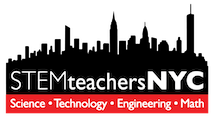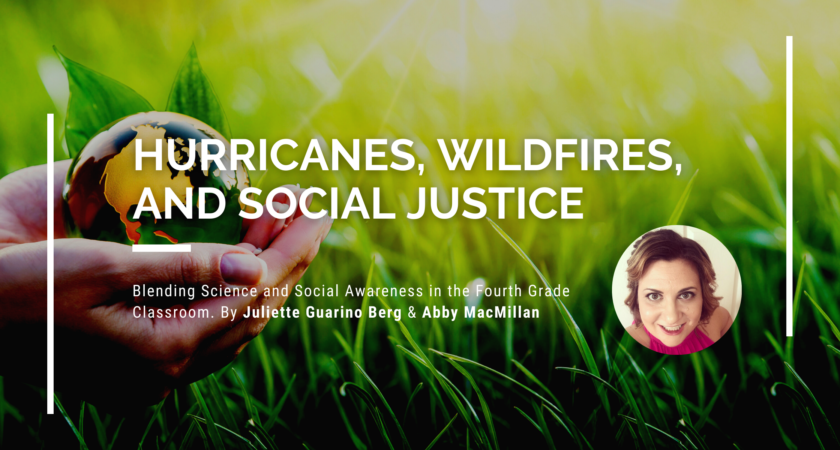While the devastation of the COVID-19 pandemic dominated the media throughout 2020, it may have been easy to forget that other tragedies were occurring in our country as well. This year, we experienced one of the most active hurricane seasons in recent history, with “a record-breaking 30 named storms and 12 landfalling storms in the continental United States” (NOAA, 2020).
Simultaneously, the West Coast suffered through a punishing wildfire season. In California alone, “more than two million acres have burned across the state…in 2020, which makes this a record year…according to the California Department of Forestry and Fire Protection” (Pierre-louis & Schwartz, 2020). In our fourth grade science classroom, we developed a unit that not only allowed students to make scientific connections between severe weather-related events and climate change, but also supported them in understanding closely related issues of social justice and human rights.
Engaging science units begin with “anchoring phenomena,” or “observable events that occur in the universe and that we can use our science knowledge to explain or predict” (Achieve, Next Gen Science Storylines & STEM Teaching Tools, 2016). To kick off this unit, students viewed recent videos of the wildfires hurtling their way across the West Coast, as well as footage of Hurricane Zeta ravaging the city of New Orleans in late October.
Then, students were posed with the question: “This year, we have experienced historic hurricane and wildfire seasons that devastated large areas of the United States. Is this a coincidence, or could these events have a common cause? If so, what is causing these events to occur?” Fourth grade scientists were then tasked with answering this question via several activities.
With a great deal of help from our Middle School Librarian, Class 4 scientists were presented with a variety of resources to help them better understand the causes and effects of hurricanes and wildfires. Each student chose one of these two phenomena to focus on and used a note-taking template to record at least three of their main “takeaways” from each source as well as answer the question:
“Does this source mention climate change or global warming? If so, what does it say?” This question allowed students to begin making connections between global warming, climate change, and severe weather-related events.
Next, students were challenged with creating an interactive model of their chosen phenomenon using SageModeler, a “free, web-based, and open-source software to engage students in systems thinking through designing, building, and revising models” (SageModeler, 2020).
Using their research notes, fourth graders chose what they felt were the “most important” causes and effects of either hurricanes or wildfires, and used this information to build their models. After mapping out their models, students used arrows to show direct and indirect relationships between variables.
For example, “an increase in unattended campfires causes wildfires to increase [in quantity or severity].” Using the “simulate” function on their models, Class 4 students were able to manipulate these variables in order to better understand relationships within the model.
Once Class 4 scientists completed their models and were able to explain them to others in the community, they were able to make concrete connections between climate change and increased instances of hurricanes and wildfires. When explaining her video, one student stated: “One of the causes [of wildfires] is global warming.
I saw using ‘simulator’ that if global warming was taken care of, then there would be a significant decrease in wildfires.” Specifically, her model showed how the increase in Earth’s average temperature is increasing the occurrences of lightning strikes, and lightning strikes are one of the many causes of wildfires. Another student explained: “Warm weather that heats the water comes from global warming.
When that happens, this causes more air to rise, and cold air to form where it was. This causes a storm to form. That makes a hurricane, which can cause injuries, damaged buildings and homes, and floods. Floods can cause injuries and damaged buildings and homes, and damaged buildings and homes can cause injuries. So, it’s a very delicate web.”
After creating and explaining their models, fourth grade scientists were asked the question: “What is social justice?” Using their knowledge of the meanings of “social” and “justice,” each section of students was able to construct their own working definition of social justice.
Every group of students concluded that “social justice” is when all people have the same rights and nobody is more powerful than anybody else. Students were tasked with reviewing and analyzing a variety of resources related to hurricanes, wildfires, and social justice issues.
Among these resources were three maps of New Orleans showing elevation, poverty rates, and census data by neighborhood (TeachRock.org, 2020) so that students could begin making comparisons between the effects of 2005’s Hurricane Katrina on people with different incomes and racial identities.
For example, two students noticed that “more Black people live in the Lower Ninth Ward,” an area of New Orleans that was significantly flooded during Hurricane Katrina. The Newsela article “Housing projects, incomplete canal put Louisiana at risk” outlined for students how developers have exacerbated already existing inequities by “building more and more houses in flood plains,” causing “more people [to] live in areas with risk of flooding” (2019).
When reviewing and analyzing resources related to wildfires and social justice, students learned about the practice of “cultural burning” and its history among the indigenous people of Australia and the Americas.
The Newsela article “California and Australia look to Indigenous land management for fire help” taught students that cultural burning occurs when “small, controlled fires [are set] during cooler months,” which “helps reduce the chance of larger fires in warmer months” (2020).
In the video “Fighting Fire With Fire: Using Cultural Burning Practices,” Class 4 scientists learned that cultural burning is “a traditional land stewardship tool employed by indigenous people all over the world,” and that the lack of contemporary controlled burns have been contributing to the size and severity of recent wildfires (2018). Students also learned that undocumented farm workers on the West Coast have been particularly susceptible to wildfire-related inequities.
The video “Pandemic, Wildfires, & Heat Wave: Undocumented Farmworkers Face Triple Threat as West Coast Burns,” states: “Despite the risks, many [undocumented farmworkers] feel that they need to keep working, even if that means working inside evacuation zones. Authorities in California have repeatedly allowed growers to continue harvesting despite evacuation orders, putting workers at great risk” (2020).
As a culminating project, each fourth grade scientist has been tasked with creating their own Google Site outlining the causes and effects of either hurricanes or wildfires as well as who is affected by the phenomenon and how we can begin solving the problem.
Students began creating their websites prior to the winter break, and will complete their websites once school has resumed in January. We are looking forward to seeing how students have blended their newfound understandings of both the science and social justice issues related to hurricanes and wildfires.
Most importantly, we are looking forward to the opportunity for students to share their findings with others in the community and begin meaningful conversations around severe weather-related events, climate change, and equity!
Article by: Juliette Guarino Berg & Abby MacMillan
Learn more about this topic
Dimensions of Responsive STEM Series
This workshop series will be led by teacher-leaders from our Culturally Responsive Teaching in STEM Task Force.
Part 2: Personal Biases
January 24, 2021
Part 3: Content Biases
February 7, 2021
Part 4: Pedagogical Biases
March 7, 2021
References
California and Australia look to Indigenous land management for fire help. (2020, September 15). Retrieved December 29, 2020, from https://newsela.com/read/specials-pearson-indigenous-fire-management/id/2001013061
Fighting Fire With Fire: Using Cultural Burning Practices. (2018, November 07). Retrieved December 30, 2020, from https://youtu.be/eg876VdW7Qk
Flood-prone Louisiana fails to curb housing sprawl and complete canal. (2019, June 26). Retrieved December 29, 2020, from https://newsela.com/read/lib-louisiana-flood-damage/id/52354
Kanye and Katrina: Environmental Racism in New Orleans. Retrieved December 29, 2020, from https://teachrock.org/lesson/kanye-and-katrina-environmental-racism-in-new-orleans/
Pandemic, Wildfires & Heat Wave: Undocumented Farmworkers Face “Triple Threat” as West Coast Burns. (2020, September 14). Retrieved December 29, 2020, from https://www.democracynow.org/2020/9/14/us_wildfires_farmworkers
Pierre-louis, K., & Schwartz, J. (2020, August 21). Why Does California Have So Many Wildfires? Retrieved December 29, 2020, from https://www.nytimes.com/article/why-does-california-have-wildfires.html
Record-breaking Atlantic hurricane season draws to an end. (2020, November 24). Retrieved December 29, 2020, from https://www.noaa.gov/media-release/record-breaking-atlantic-hurricane-season-draws-to-end
SageModeler Systems Modeling Tool. Retrieved December 29, 2020, from https://sagemodeler.concord.org/
Using Phenomena in NGSS-Designed Lessons and Units. (2016, October). Retrieved December 29, 2020, from http://stemteachingtools.org/brief/42
Images
Excerpt from a Student’s Note-taking Document
Excerpt from a Student’s Note-taking Document
A Student’s Hurricane Model
A Student’s Wildfire Model



